How to Schedule Windows to Turn On Automatically at a Specific Time
If you use your computer for study or work, you will most likely turn it on at a specific time. If you do this manually, you have to wait a few minutes for the computer to boot before you can get started.
This is where scheduling a computer start can be handy. In the following, we will teach you how to do this in the Windows 10 operating system.
If you do not have the patience to turn on your Windows PC manually, you can put it to Sleep or Hibernate mode and then use the tools that turn it on at the specified time. This way, you can do certain things on your computer before using it.
What is the use of scheduling a computer start?
Scanning a Windows computer can help you save time. You must set your computer to Sleep or Hibernate mode to do this. Sleep mode can be helpful if you want to use your computer after a short break. If you do not wish to use your laptop for a long time and do not want to turn it off, then the Hibernate feature can work for you.
If you want it to turn itself off, do certain things, and turn off again when you are away from your computer, scheduling it to turn on can help.
This feature can still be useful if you want to complete your downloads at a certain time or scan your computer (to find a virus). It can also help you with Hard Disk Defragmentation. Such processes may take hours, so it is best to do them when you are not using your computer.
If you want to use your computer as an alarm clock, it must be turned on automatically again; otherwise, it will not work. In addition, scheduling the computer to start can save you from enduring the boot process. Here’s how to do it.
1. Automatically turn on the computer using the Task Scheduler
You can turn on your computer automatically using one of your Windows 10 applications called Task Scheduler.
In the Start menu search bar, type “Task Scheduler” and select the best result. In the right panel of the Task Scheduler window, you must click on “Create Task”.

In the window that appears, you must select a name for your function. Try to choose a recognizable name, like PowerOn. This way, you can easily find this function in the future and distinguish it from others.
In the same window, check the boxes next to “Run whether user is logged on or not” and “Run with highest privileges.” In the “Configure for” drop-down menu, select “Windows 10.”
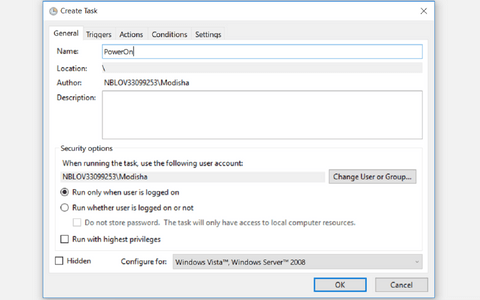
Next, go to the “Triggers” tab and click on “… New.” This will allow you to determine the conditions that lead to the performance of your desired action.
In the “Begin the task” drop-down menu, select “On a schedule.” This will give you the function you want according to the specified schedule. Then, check the “Daily” option to set the function to be activated daily.
In the “Start” section, enter the desired time and date to perform the operation. Click “OK” to continue.

Task Scheduler prompts you to create at least one action to run when the computer turns on. You can select a standard action, such as running the Snipping Tool or any other application.
To do this, go to the “Actions” tab and click “… New” to specify what happens when you start the action.
In the window that appears, select “Start a program” in the “Action” drop-down menu. Click the “Browse” button to find the application you want to run after the computer is turned on. Then click “OK” to continue. In this article, we have chosen the Snipping Tool.

The next step is to go to the “Conditions” tab. Here, you must check the “Wake the computer to run this task” option and uncheck the other options. Click “OK” to continue.
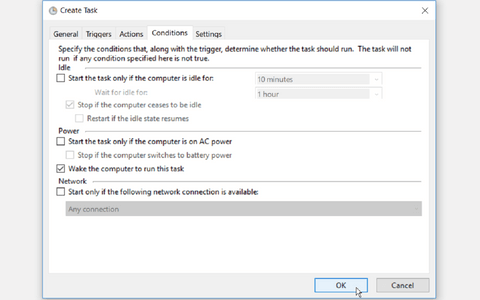
The last step is to make sure that your computer’s power plan (wake timers) allows you to do this. If this feature is disabled, your scheduled function will not work either.
To set this feature, you must access the control panel by typing “Control Panel” in the Start menu.
Next, go to “Hardware and Sound> Power Options> Change Plan Settings> Change advanced power settings.”
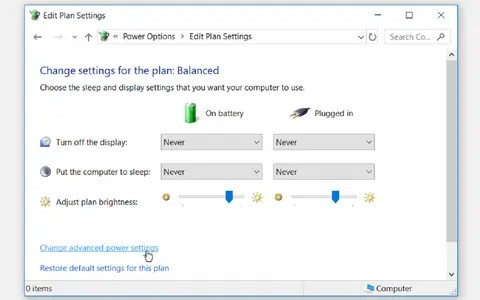
In the “Advanced settings” tab, go to “Sleep> Allow wake timers.” Set “On battery” and “Plugged in” to “Enable.” Click “Apply” and then “OK.” This way, you can put your computer in Sleep mode, and it will turn on at the specified time.
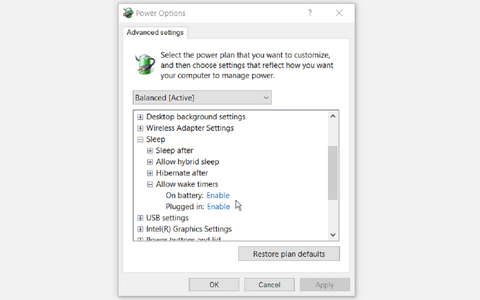
2. Use of third-party software
If you do not want to use Task Scheduler, you can use third-party software to schedule your computer’s turn-on. The “WakeupOnStandBy” tool can put your computer out of Sleep mode (based on the conditions you have set in that program).
- Download WakeUpOnStandBy, extract the zip File, and then run the application.
- In the “Specify time to wake up computer” section, you must specify the time and date when turning on your computer. You should check the box if you want the screen to turn on or if you want something to do when the laptop turns on.
- In the “Run the following File/program/web page when the computer wakes up” section, you can specify the programs you want to run.
- You can determine what your computer will do after the tasks by checking the appropriate option in the “Specify what to do next” section.
- You can specify when your scheduled tasks will be repeated by checking the option in the “Repeat these tasks” section.
- To activate the desired function, you must click on “Start”.
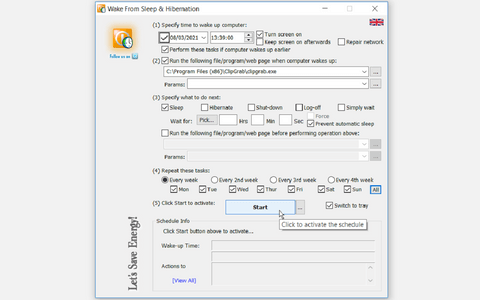
What sets WakeOnStandBy apart is that it’s easy to work with. To make things easier, the tool also provides an online guide for users to access by pressing the “F1” key.
Concluding Remarks
Above, we introduced you to the solutions for automatically turning on Windows computers. This will allow you to do things automatically and avoid delays in the boot process.
FAQ
Can I make my PC start up automatically every day?
Yes — by creating a scheduled task set to “Wake the computer to run this task” and enabling wake timers in your power settings.
Do I need my PC in Sleep or Hibernate mode for this to work?
Yes — the method typically works when the computer is in Sleep or Hibernate mode; the system must support waking from those states.
Is third-party software required for this feature?
No — Windows’ built-in Task Scheduler can do this, though third-party tools like “WakeUpOnStandBy” offer a more user-friendly interface.
